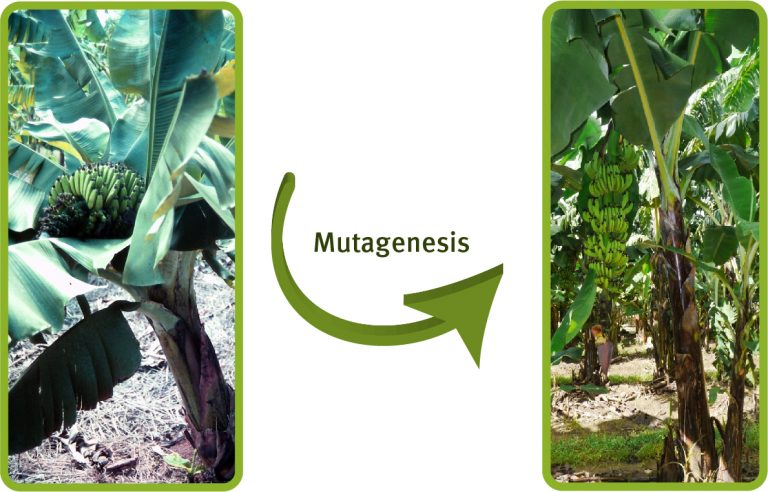Banana variety research — the search for new resistant varieties
The search for new banana varieties that have both desirable agronomic characteristics and resistance to pests and diseases, especially Panama disease tropical race 4, is a current hot topic in the banana industry. This page gives you background into banana breeding techniques and links you to the latest progress updates from industry funded variety trials.
How do you 'breed' a new banana variety?
The development of new banana varieties is a slow and costly process, with high levels of infertility making it difficult to do conventional breeding from some commercially important varieties like Cavendish.
Banana breeding techniques fall into three broad categories:
- Conventional breeding is when fertile male and female lines are crossed using pollen to produce seeds. The seeds are germinated and the seedlings are screened for the desired improved attributes. This method is extremely time consuming and labour intensive, however, there are many benefits by using and introducing the wider range of genetic diversity from wild banana cultivars. Improved banana cultivars are imported into Australia for evaluation.
- Mutation breeding and somaclonal variation uses induced mutations in existing cultivars to produce plants with desirable attributes such as pest or disease resistance, improved plant stature and increased yield.
Selection of improved cultivars via somaclonal variation (off-types), induced by plant tissue culture, was pioneered by the Taiwan Banana Research Institute (TBRI) to develop Cavendish varieties with increased levels of resistance to Panama disease tropical race 4.
Mutagenesis applies chemical or gamma irradiation treatment to tissue cultured plants to fast track genetic changes, thereby causing a higher rate of off-type plants than somaclonal variation induced by tissue culture alone. Australian scientists were at the forefront of developing and using this method in banana in the 1990s. Both methods produce plants with potentially desirable characteristics, however, there are also many plants that have detrimental changes.
- Genetic modification involves the manipulation of the banana DNA, by inserting identified genes for desirable characteristics from bananas or other organisms. Newer techniques include the manipulation of the plant’s own genes without the introduction of any external genetic material.
What types of 'breeding' is the banana industry investing in?
There are two key variety initiatives funded by the Australian banana industry. Currently through the project Improved Plant Protection for the Banana Industry (BA16001), which is part of the Hort Innovation Banana Fund, the industry is continuing to invest in variety importation and screening. This means that we import varieties – either from conventional breeding programs or somaclonal selection programs, ensure they are disease free and trial them under research agreements with each respective breeding program.
There are three field screening sites for these varieties.
- Coastal Plains Research Farm (Northern Territory)
- South Johnstone Research Station (Far North Queensland)
- Duranbah (New South Wales).
The second key activity under way is the use of somaclonal selection to develop resistant varieties. As mentioned earlier, somaclonal selection relies on induced mutations in existing varieties, to produce plants with desirable attributes such as, pest or disease resistance, improved plant stature and increased yield. To increase the amount of variation of somaclonal selections, researchers are using mutagenesis to induce genetic mutations in selected cultivars by means of gamma irradiation. As part of this work, four varieties that have improved levels of resistance to Panama disease tropical race 4 have recently undergone mutagenesis to improve their agronomic characteristics.
- GCTCV119 is a somaclonal Giant Cavendish Tissue Culture Variant from the Taiwanese Banana Research Institute (TBRI).
- Goldfinger is highly resistant to Panama disease tropical race 4. It has been conventionally bred from The Honduras Foundation for Agricultural Research (FHIA).
- Dwarf Nathan is a naturally selected extra dwarf Cavendish originally from Israel.
- CJ19 is a Cavendish selection from Indonesia.
Did you know...
Department of Agriculture and Fisheries scientists, used mutagenesis in the early 1990s to develop DPM25 as a Cavendish selection. DPM25 has acceptable resistance to Panama disease subtropical race 4 and similar yield as Williams. It was developed from the Extra Dwarf Cavendish, Dwarf Parfitt, using tissue culture and gamma irradiation.

Steering the direction for variety R&D
With the limited resources available and the high priority for identifying resistant varieties, it is essential that the research and development investment decisions, represent the best value for the Australian banana industry. A key part of this is the development of the Banana Variety Subcommittee (BVS). The BVS consists of banana growers, supply chain businesses and researchers, and focuses on the broad strategic issues associated with variety importation and development. If you have any questions please don’t hesitate to talk to one of the BVS members or contact the better bananas team via email betterbananas@daf.qld.gov.au or phone 13 25 23.
The mutagenesis trial work is part of the Fusarium Wilt Tropical Race 4 Research Program (BA14014), which is funded by Hort Innovation, with co-investment from the Queensland Department of Agriculture and Fisheries and contributions from the Australian Government.
The variety importation and screening activity is part of the Improved Plant Protection for the Banana Industry Program (BA16001). This project has been funded by Hort Innovation, using the banana research and development levy, co-investment from the Queensland Department of Agriculture and Fisheries and contributions from the Australian Government.
Hort Innovation is the grower-owned, not-for-profit research and development corporation for Australian horticulture.


